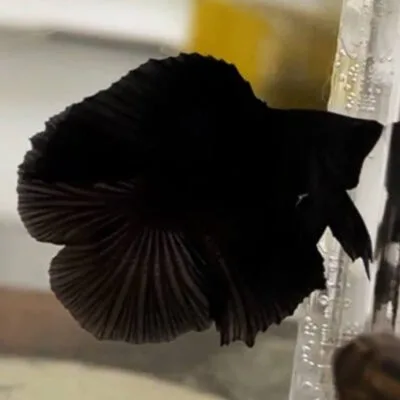MAA Blog, Show Betta Variations Spotlight
10 Top Tips for Developing Top-Quality Black Betta Fish
The black betta fish, a striking and exotic member of the betta family, is admired for its deep, velvety color and elegant form. Achieving a flawless, pitch-black coloration without iridescence can be a challenge due to complex genetic factors and breeding limitations. Black bettas, especially the “melano” variety, require specific care and selective breeding to reach their true aesthetic potential. This article will provide 10 essential tips for developing top-quality black betta fish, covering everything from color standards to common breeding issues.

Understand the Ideal Coloration of Black Betta Fish
The perfect black betta is characterized by a rich, dense black color, often compared to the shade seen in black mollies. This dark hue should be uniform and free from iridescence, which is the shiny, reflective quality often caused by breeding with other colored bettas. When breeding black bettas, particularly those in the “melano” category, it’s crucial to avoid any unwanted color interferences like steel blue or green iridescence. Iridescence is a significant flaw in black bettas because this color category should be non-reflective and free from shiny or metallic elements.

The Challenge of Breeding Black Betta Fish
Breeding black betta fish is more challenging compared to other dark-colored varieties. One reason is the difficulty in producing fertile black females. Historically, black females in many lines have been infertile, making the breeding process complicated. Breeders often use females from other color strains, such as steel blue, to overcome this issue. However, this practice introduces iridescence into the black betta, which is undesirable.
Fortunately, a newer strain called “Double Black,” developed around 2003, combines “True Black” and “Black Lace” traits, producing fertile melano females. This advancement allows for better-controlled breeding and fewer iridescence issues. It’s important to focus on keeping the black coloration pure while minimizing any iridescence from creeping into the gene pool.
Avoid Iridescence in Black Bettas
Iridescence is one of the most common issues breeders encounter when developing black bettas. Whether it’s a steel blue or greenish shine, any reflective quality significantly detracts from the ideal black appearance. While steel blue iridescence is more tolerable than green or blue, it is still considered a flaw.
In cases where iridescence is prominent, the fish may need to be reclassified into a different color category, such as dark-body bi-colors or multicolors. The goal is always to develop a black betta with no reflective hues. If metallic or opaque traits are present, the fish may also need to be reclassified, especially if the metallic elements manifest as uneven patches of color, like yellow spots against a black background.
Focus on Breeding “True Black” and “Double Black” Strains
To maintain the purity of black bettas, it’s essential to focus on breeding from established black strains, such as “True Black” and “Double Black.” These lines have been developed specifically to reduce iridescence and improve color density. “Double Black” bettas, in particular, are favored because they produce fertile females, allowing breeders to avoid using females from other color lines, which can introduce unwanted traits.
By carefully selecting breeding pairs from these strains, you can significantly reduce the chances of iridescence or color faults appearing in future generations.

Pay Attention to Fin and Body Uniformity
For a black betta to be considered of high quality, its body and fins must have a consistent black color without any signs of translucency or uneven shading. A common fault in black bettas is translucent webbing between the fin rays, which detracts from the fish’s overall appearance. Ideally, the fins should display the same deep black color as the body, with no clear or streaky areas. Any red, clear, or streaky spots on the fins are minor faults unless they are extensive, in which case the fish may need to be moved to a multicolor or butterfly class.

Watch for Metallic and Rust Intrusion
Another issue that can occur in black bettas is the presence of metallic colors or rust-like spots. Metallic iridescence is particularly problematic if it appears unevenly, as this can cause the black color to appear splotchy. Rust, which manifests as reddish-brown spots, is a severe fault that must be avoided. If these issues are widespread, the fish may need to be reclassified into a different category, such as bi-color or multicolor. Breeding for pure black without these intrusions requires careful selection of breeding pairs with a long history of consistent, non-iridescent black coloration.
Minimize the Presence of Red and Clear on the Fins
While some red or clear spots on the fins may be tolerable, extensive markings are considered a fault and can lower the fish’s overall quality. In severe cases, where large areas of the fins are red or clear, the black betta may need to be placed into the multicolor or butterfly class, as its color would no longer qualify as pure black. To avoid this issue, make sure to select breeding pairs with solid black fin coloration and avoid introducing fish with extensive red or clear streaks into the breeding line.
Eliminate Steel Blue and Green Iridescence
Steel blue and green iridescence are particularly problematic in black bettas. These reflective hues often result from using females from other color strains, like steel blue, in the breeding process. While steel blue iridescence is less serious than green or blue iridescence, both are considered significant flaws, especially when covering large areas of the body. If the iridescence is extensive, the fish should be reclassified as a dark-body bi-color or even placed into the multicolor class.
To prevent iridescence, it’s best to breed black bettas from lines that have been carefully developed to minimize reflective traits.
Check for Opaque Intrusion
Opaque traits are also a disqualifying fault in black bettas, particularly when the opaque coloring covers large areas of the body or fins. The only place where opaque is acceptable is on the ventrals, the small fins located beneath the fish’s body. If opaque traits appear elsewhere, the fish should be disqualified from the black category.
Breeding for non-opaque black bettas requires selecting breeding pairs with a long history of pure black coloration, without any signs of opaque traits in their lineage.
Be Mindful of Common Color Faults
In black bettas, several specific color faults are common and should be minimized through selective breeding. These include:
- White ventrals: This is a slight fault that can be tolerated but should be minimized.
- Color missing from pectorals: Another slight fault, often seen in black bettas.
- Red on fins: Minor if limited, but extensive red coloring can be a major fault.
- Clear streaks on fins: Can be minor or major, depending on the extent.
Paying attention to these faults and breeding fish that meet the ideal black betta standards will help you develop top-quality specimens.
FAQs
What is the ideal color for a black betta fish? The ideal color for a black betta fish is a dark, dense, non-iridescent black, often referred to as “pitch black” or “melano.”
Why is iridescence a problem in black bettas? Iridescence detracts from the desired solid black appearance of the fish and is considered a major flaw, especially in steel blue or green shades.
How can I breed black bettas without introducing iridescence? Use established black strains like “True Black” or “Double Black” and avoid breeding with females from other color lines that can introduce reflective traits.
What is a “Double Black” betta? The “Double Black” strain is a combination of True Black and Black Lace traits, developed in 2003, that produces fertile melano females, improving breeding success.
What are some common color faults in black bettas? Common color faults include white ventrals, color missing from pectorals, red on fins, clear streaks on fins, and iridescence.
How can I improve the quality of my black bettas’ fins? Select breeding pairs with consistent black coloration on both the body and fins, and avoid introducing fish with translucent, red, or clear streaks on their fins.
Conclusion
Developing top-quality black betta fish requires a deep understanding of their genetics, strict attention to coloration, and careful selection of breeding pairs. By focusing on breeding non-iridescent, pitch-black bettas from reliable strains, you can minimize common faults and produce stunning, high-quality specimens that meet the ideal standards.

